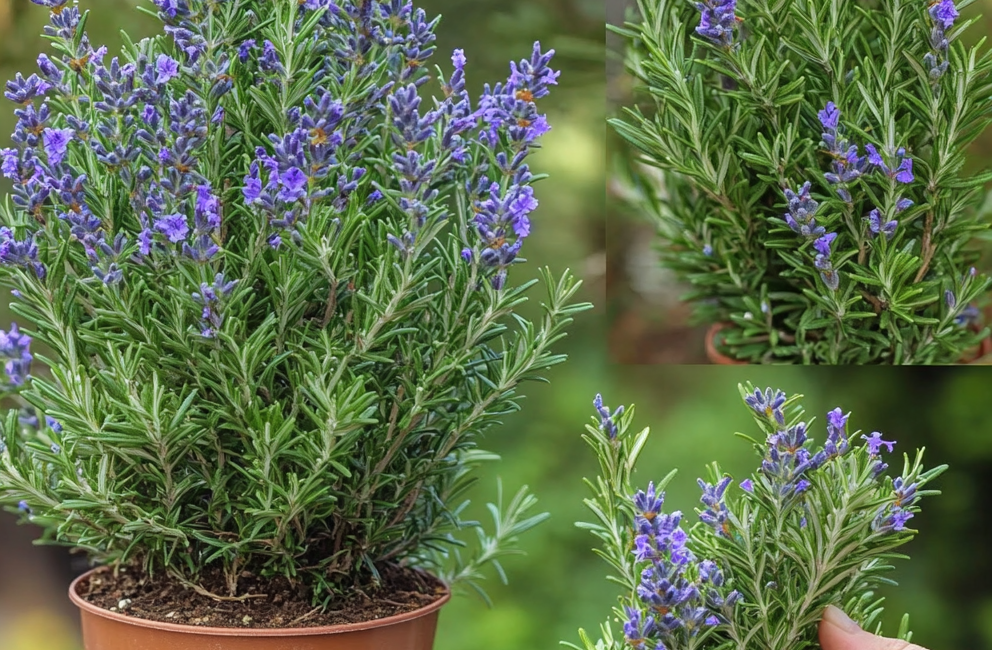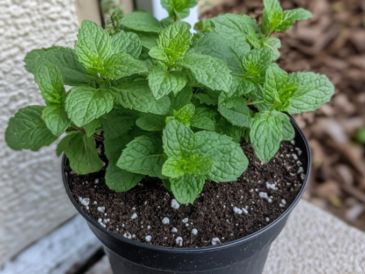Rosemary isn’t just a versatile herb for cooking; it’s also a fragrant plant that can fill your home with a delightful aroma. Whether you’re growing rosemary indoors or using fresh or dried flowers, this guide will walk you through everything you need to know to make your entire home smell like a Mediterranean garden.
Part 1: Growing and Harvesting Fragrant Rosemary Flowers
1. Choose the Right Rosemary Variety for Fragrance
Not all rosemary plants are created equal when it comes to fragrance. For the most aromatic experience, select a variety known for its potent scent.
- Common Rosemary (Rosmarinus officinalis): The most widely grown, it has a strong, classic rosemary scent.
- ‘Tuscan Blue’ Rosemary: Known for its intense aroma and beautiful blue flowers, this variety is perfect for filling your home with fragrance.
- ‘Blue Spires’ Rosemary: This variety offers both an attractive appearance and a strong, woodsy fragrance.
🌿 Pro Tip: Consider planting multiple varieties to create a blend of fragrances that can range from sweet to spicy.
2. Planting Rosemary for Maximum Growth and Scent
To ensure your rosemary thrives and produces fragrant flowers, follow these planting tips:
- Sunlight Requirements: Rosemary loves sunlight. Plant it in a spot that receives at least 6-8 hours of direct sunlight daily. The more sun, the more fragrant the plant will be.
- Soil Conditions: Rosemary prefers well-draining soil with a slightly alkaline pH (6.0-7.0). Sandy or loamy soil works best.
- Container Gardening: If planting indoors or in less-than-ideal soil, use a large pot with well-draining potting mix.
- Watering: Rosemary is drought-tolerant once established but needs regular watering when young. Water the plant when the top inch of soil feels dry, but avoid waterlogging, which can lead to root rot.
🌸 Indoor Growing Tip: Place rosemary near a sunny window, preferably facing south. Turn the pot regularly to ensure even growth.
3. Caring for Your Rosemary to Encourage Flowering
Proper care will lead to a healthy plant that produces an abundance of fragrant flowers.
- Pruning: Regular pruning encourages bushier growth and more flowers. Trim back about a third of the plant in spring to promote new growth.
- Feeding: While rosemary doesn’t need heavy feeding, a balanced, all-purpose fertilizer in spring can boost its growth.
- Pest Control: Keep an eye out for common pests like aphids and spider mites. Use neem oil or insecticidal soap if needed.
🌱 Year-Round Care: In colder climates, bring rosemary indoors during winter or protect outdoor plants with frost cloth to ensure they survive and thrive.
4. Harvesting Rosemary Flowers for Maximum Fragrance
Timing and technique are key when harvesting rosemary flowers to capture their full scent.
- Best Time to Harvest: Harvest rosemary flowers in the morning after the dew has dried but before the sun becomes too intense. This is when the essential oils are most concentrated.
- Harvesting Method:
- Use sharp scissors or pruning shears to snip off flowering stems.
- Leave a few inches of stem on the plant to encourage regrowth.
- Frequency: Regular harvesting not only provides a steady supply of fragrant flowers but also encourages the plant to produce more blooms.
🌼 Storage Tip: If you can’t use the flowers immediately, dry them in a cool, dark place to preserve their scent. Store dried flowers in an airtight container away from direct sunlight.
Part 2: Making Your Home Smell Amazing with Rosemary Flowers
5. Using Fresh Rosemary Flowers to Infuse Your Home with Scent
Continue reading “PAGE 2” to learn how to fill your home with the delightful aroma of rosemary flowers in every room!
Fresh rosemary flowers are incredibly versatile and can be used in various ways to naturally scent your home.
- Rosemary Flower Arrangements:
- Place fresh sprigs in vases throughout your home. As the flowers dry, they’ll continue to release their fragrance.
- Create small bouquets for your bathroom, kitchen, or living room to keep these spaces smelling fresh.
- Simmering Potpourri:
- Add fresh rosemary flowers to a pot of water with slices of lemon, cinnamon sticks, and cloves. Simmer on the stove to fill your home with a warm, herbal scent.
- Natural Air Fresheners:
- Bundle rosemary sprigs with twine and hang them in closets, near windows, or from curtain rods to release a continuous fragrance as they dry.
🌿 Quick Tip: Replace fresh rosemary sprigs every 1-2 weeks to maintain a consistent aroma.
6. Creating DIY Rosemary Sachets and Potpourri
Dried rosemary flowers can be transformed into long-lasting sachets and potpourri that keep your home smelling wonderful.
- DIY Rosemary Sachets:
- Place dried rosemary flowers in small, breathable fabric bags.
- Add other dried herbs or flowers like lavender, mint, or rose petals for a custom blend.
- Place sachets in drawers, closets, or under pillows for a fresh scent that lasts for months.
- Homemade Potpourri:
- Combine dried rosemary flowers with other fragrant ingredients like dried citrus peels, cloves, and cinnamon sticks.
- Display the potpourri in decorative bowls around your home for both fragrance and visual appeal.
🛏️ Bedroom Bliss: Place sachets under your pillow or near your bed to enjoy the calming, sleep-inducing effects of rosemary as you drift off.
7. Making Rosemary-Infused Cleaning Products
Rosemary’s natural antibacterial properties make it an excellent addition to homemade cleaning products.
- Rosemary Vinegar Cleaner:
- Fill a jar with fresh rosemary flowers and white vinegar. Let it steep for 2-3 weeks, then strain the liquid.
- Use the infused vinegar as a natural, aromatic cleaner for windows, countertops, and floors.
- Rosemary Essential Oil Spray:
- Mix 10-15 drops of rosemary essential oil with water in a spray bottle.
- Use as an all-purpose air freshener or surface cleaner with a refreshing, herbal scent.
🌸 Eco-Friendly Tip: These natural cleaners are not only effective but also safe for use around children and pets.
8. Enjoying the Long-Lasting Aroma of Rosemary in Every Room
With a little creativity, you can ensure the scent of rosemary lingers in every corner of your home.
- Candle Making:
- Create your own rosemary-scented candles by adding dried rosemary flowers or rosemary essential oil to melted wax.
- Light these candles during the evening to fill your home with a soothing, herbal aroma.
- Scented Decor:
- Weave fresh rosemary sprigs into wreaths, garlands, or centerpieces. As they dry, the flowers will continue to release their fragrance.
- Bath and Body Products:
- Infuse bath salts, soaps, and lotions with dried rosemary flowers or rosemary essential oil for a spa-like experience at home.
🕯️ Final Touch: Place candles and scented decor strategically in high-traffic areas, such as the entryway or living room, to create an inviting atmosphere for both residents and guests.
Keep reading to discover how to fill your home with the delightful aroma of rosemary flowers in every room!
9. Maximizing the Benefits of Rosemary’s Fragrance
Beyond its pleasant scent, rosemary offers numerous benefits for your home and well-being.
- Natural Deodorizer: Rosemary naturally neutralizes odors, making it perfect for kitchens, bathrooms, and pet areas.
- Mood Booster: The scent of rosemary is known to reduce stress, improve concentration, and boost overall mood. Use it in your workspace to enhance focus and creativity.
- Sleep Aid: Rosemary’s calming properties can help improve sleep quality. Place sachets or pillows infused with rosemary near your bed for a restful night.
🌿 Pro Tip: Combine rosemary with other herbs like lavender or chamomile to create a soothing blend that enhances relaxation and well-being.
Conclusion: Let Rosemary Flowers Transform Your Home
By following these steps, you can easily make rosemary flowers a central part of your home’s ambiance. Whether you’re growing rosemary indoors, using it in homemade cleaning products, or crafting scented decor, the possibilities are endless. Embrace the natural beauty and fragrance of rosemary to create a home that smells as wonderful as it looks.
Get started today and let the enchanting scent of rosemary fill your home with warmth and tranquility!




